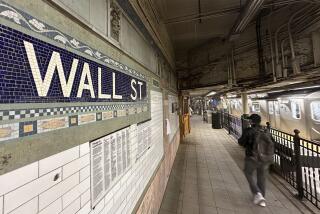Reports Offer Murky Picture on Short-Term Interest Rates
A barrage of reports released Tuesday failed to provide a definitive picture of the economy, leaving analysts uncertain about the direction of short-term interest rates.
Rising mortgage rates began to curb new-home sales in June, according to one report. But consumer confidence jumped in July to a six-year high, suggesting that spending, which makes up two-thirds of the nation’s economic activity, will continue at a good clip.
And while employment costs rose moderately in June, shortages of skilled labor continued to develop, which could drive payroll and benefit costs up even faster and force businesses to boost prices.
As a result, the odds are only slightly better than even that Federal Reserve Board policymakers will boost interest rates at their Aug. 20 meeting to ensure a slower economy and subdued inflation, said economist David Jones of Aubrey G. Lanston & Co., a New York government securities dealer.
Most financial markets closed higher Tuesday after a jittery session. Bonds posted their largest gain in eight days, and the Dow Jones industrial average rose 47.34 points to 5,481.93 after sliding as much as 12.01 points earlier.
Attention was focused on the Labor Department’s employment cost index, a key inflation component, which barely budged in the second quarter. Wage, salary and benefit costs for U.S. businesses rose 0.8% in the quarter, the same as the previous quarter.
“Fears of wage acceleration remain just that,” said Bruce Steinberg, an economist at Merrill Lynch & Co., in New York. “Compensation costs remain under control.”
The index is regarded as the best measure of labor costs, which represent two-thirds of the price of a product. The index indicates whether payroll costs are rising so fast as to force consumer price increases.
But while the gains in employment costs were viewed as modest, the National Assn. of Business Economists released a survey suggesting that wage pressures were heating up.
The survey of 103 members found 47% of their companies experiencing shortages of skilled labor during the second quarter, up from 32% in the first quarter.
Consumer confidence moved higher as the third quarter began, another indication of strong economic growth that could fuel price pressures. The Conference Board in New York said its index of consumer attitudes rose from 100.1 points in June to 107.2 in July, the highest since May 1990.
But a 5.3% drop in new-home sales in June and a huge downward revision in sales in May--to a 1.2% increase from 7.5% originally--were fresh signs of a slowdown in the housing industry.
The Commerce Department said sales totaled a seasonally adjusted 734,000 annual rate, down from 775,000 in May.
Earlier reports showed existing-home sales also fell in June and that applications for building permits--often a barometer of future activity--also dropped.
“Higher [mortgage] rates are provoking some slowing in housing activity,” said David G. Seiders, an economist with the National Assn. of Home Builders. Rates have shot up more than a percentage point since January.
But here, too, the picture was mixed. New-home sales were up in the Northeast and West but fell in the Midwest and South.
Also Tuesday, the National Assn. of Realtors said its housing affordability index fell to 122 in the second quarter, down from 131.5 in the first three months and the lowest since 118.9 in the second quarter of 1992.
(BEGIN TEXT OF INFOBOX / INFOGRAPHIC)
Consumer Confidence
From a monthly survey of 5,000 U.S. households. Index; 1985 = 100
July: 107.2
Source: Conference Board
More to Read
Inside the business of entertainment
The Wide Shot brings you news, analysis and insights on everything from streaming wars to production — and what it all means for the future.
You may occasionally receive promotional content from the Los Angeles Times.










